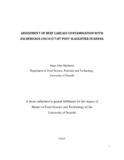| dc.description.abstract | A cross sectional study was carried out on meat sourced from three slaughterhouses: Dagoretti in Nairobi, Limuru in Limuru and Eldoret Township in Eldoret. The objectives of the study were to assess the probability of obtaining an Escherichia coli O157 serotype contaminated carcass at loading, off loading and butchery stages of the transportation value chain, the prevalence of E. coli O157 serotype contamination of the carcass at the three stages and at the butchery equipment and highlight the unhygienic practices that could lead to the contamination and cross-contamination of the carcasses at each stage of transportation.
The three slaughterhouses were selected on the basis of they being the main sources of meat consumed in Nairobi and Eldoret; the former being the capital city of Kenya and the most populated and the latter a stopover town in transit to the western side of Kenya. A total of 250 carcasses were randomly selected for non destructive sampling. Swab samples from a single carcass were obtained from three sites of the carcass, including the rump, the flank and the brisket at the three stages of the transportation value chain; the loading, the off loading and follow up after a day at the butchery. Swab samples were also obtained from four butchery equipment that was constantly in contact with the meat during sale: the cutting/chopping board, the knives/saw, the hooks and the weighing balance. A single carcass delivered to the butchery gave rise to eleven samples giving a total of 2750 samples.
E. coli O157 serotype was isolated through culturing in sorbital MacConkey agar, further purification in MacConkey agar and nutrient agar and then serotyping using card agglutination test. The confirmed serotype were then tested for verotoxin production (both VT1and VT2). The prevalence was determined through running data using Statistical Package for Social Sciences (SPSS) ver17. The prevalence data was then modelled to determine the probability of carcass contamination at each stage of sampling. Monte Carlo simulation using winBUGS® software was used to determine the risk of obtaining contaminated carcass at each stage. The meat carrier temperature and humidity were taken using a sling hygrometer. A semi structured questionnaire was used to assess the knowledge, attitude and practice of the meat transporters and butchery attendants. Observations were made on some of the practices by these key players.
The presumptive E. coli O157 isolates (non sorbital fermentors and with IMViC reaction of ++-) recovery from 2750 samples was 217 (7.89%). Only 20 (9.21%) of the presumptive isolates were positive for E. coli O157 serotype. The E. coli O157 serotype isolates that tested positive for verotoxin production were; one for VT1, two for VT2 and one for both VT1 and VT2. These were distributed along the transportation value chain of meat from the three slaughterhouses. The prevalence of E. coli O157 serotype contaminated carcasses was 2.4% along the transportation value chain and that of contaminated equipment at the butchery was found to be 0.6%. The contamination prevalence at offloading was significantly higher compared to loading (P=0.05). The probability of obtaining an E. coli O157 serotype contaminated carcass at Dagoretti, Limuru and Eldoret respectively was 14, 16 and 19 at loading and 31, 39 and 66 at offloading per 1000 carcasses handled. The temperature in the meat carrier significantly increased (p=0.004) during transportation between loading and offloading. The average time taken to transport the meat from the slaughterhouses to the butchery was found to be 65 minutes.
The respondents interviewed for the knowledge, attitude and practices were 119 where 87 were butchery attendants and 32 meat transporters. Of those interviewed, 83 (69.75%) had worked in the meat industry for at least 5 years but only 19 (16%) had had formal training on meat hygiene. Most of the butchery attendants interviewed (97%) said they washed their hands frequently although only 9% of the butcheries had functional water taps in their premises. The meat transporters did not wash their hands during the transportation although 53% had said that they did so regularly. Cleaning of the butchery surfaces was done using cold water and soap only and no disinfectant was used.
During meat transportation, it was observed that the carcasses were loaded on the shoulders of the transporters and placed on the floor of the carriers or heaped on top of other carcasses. Offloading at the butchery was done by the same person without any change over of clothes. Kraft papers were used to separate the carcasses and avoid staining those beneath with blood. Bacteriological quality of the papers was unknown. These unhygienic practices in combination with the temperature increase during transportation could have led to the significant increase in contaminated carcasses at offloading as compared to loading. Therefore this significant increase was mainly due to cross contamination and bacterial multiplication.
There was risk of obtaining contaminated carcasses at the three stages of sampling. The risk increased along the transportation value chain. This was due to poor hygiene practices by both the transporters and butchery attendants who had little information on prevention of carcass contamination. Increase in temperature due to lack of the observation of the cold chain also led to the increase in the prevalence and probability of obtaining a contaminated carcass. E. coli O157 serotype contamination in the carcass could persist from loading to offloading. | en_US |



